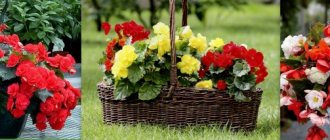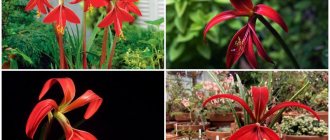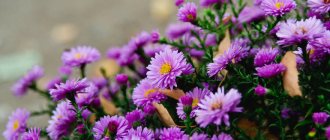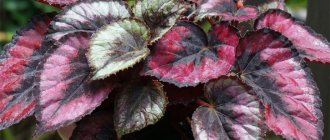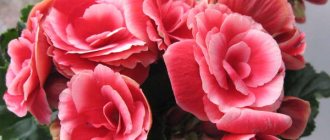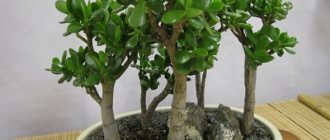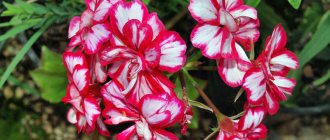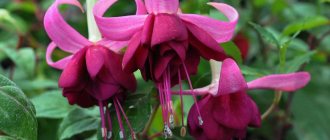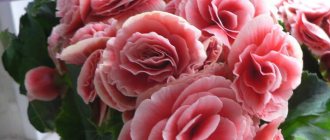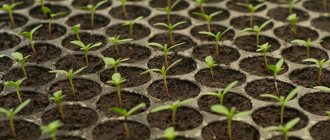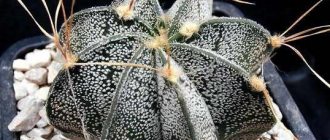Characteristics of the subspecies
A subspecies of tuberous begonias is ampelous, and can also be called cascading or pendula. The latter are often sold in stores as a series of varieties of hanging begonias, with differences in color characteristics.
These are herbaceous plants with a succulent stem, tuberous roots and asymmetrical toothed leaves. The main interest for gardeners is its flowers. Terry varieties of hanging begonias have male and female flowers. The male ones are larger and bloom first, the female ones appear later and are non-double in the structure of the bud. It turns out that one bush can have both double and non-double inflorescences at the same time.
With proper care, the flowering of tuberous begonias is lush, to the point that the foliage is practically invisible because of the flowers. The petals come in different shades of yellow and red, orange, pink, coral and salmon. There are varieties in which the edge of the petal is edged with a different color.
The sizes of flowers vary from small - 2-3 cm in diameter, to giant - 15-20 cm. They are also different in shape: double and regular, similar to roses, peonies, camellias and even daffodils. During the period of active flowering, pendula bushes turn into lush “caps” of bright colors.
Due to the characteristics of hanging varieties, they are used mainly for landscaping terraces and balconies, loggias, shop windows, grown in hanging boxes and flower pots. It grows quite well at home, however, in the warm season it is still preferable to send it to fresh air.
Description of the flower
The long thin shoots of the plant are strewn with small multi-colored flowers and have a spectacular appearance. The size of the inflorescences in diameter ranges from 2 to 8 cm, depending on the variety. The length of the shoots reaches 40 cm, and in double and semi-double hybrids, this size is 80 cm.
The flowering period of each inflorescence is at least 10 days. The colors of ampelous begonia can be: white, bright red, soft pink, burgundy, crimson, pale yellow. You will learn about the types and varieties of begonia with yellow flowers here, and read about the bright red beauty here.
Falling types are great for decorating outdoor vertical structures.
Moreover, the flowering period of the plant is quite long, from late spring to late autumn. Many hybrid varieties do not lose their attractiveness even with the onset of rain and the first frost.
You will find descriptions of Maple-leaved, Imperial, Fist, Griffith, Terry and Bush begonias in other articles. We will tell you in detail about the care, propagation and cultivation of these flower varieties.
Popular varieties
Garden begonia 'Illumination Apricot'
Some varieties of hanging begonias are combined into series. For example:
- Illumination – plants of this series grow quickly, branch well and bloom luxuriantly. Shoots up to 30 cm hanging. Double flowers with a diameter of 5 to 7 cm. The series is presented in four colors. The most popular variety in the series can be safely called Illumination apricot.
- Sensation is a dwarf cascading begonia with very large double flowers up to 10-12 cm in diameter. The series is particularly resistant to bad weather conditions.
- The variety series Opium, or Odorata, are compact bushes with shoots up to 25 cm and large double flowers up to 10 cm. These begonias are distinguished by the presence of a delicate aroma. Varieties: Begonia Odorata Fragrant Red, Odorata Pink Delight, Opium Red, Opium White
Begonia "Champagne"
And also Cascade Apricot Gold, Double Dark Red and the mesmerizing beauty of Cascade Picotee Florence.
"Cascade Picotee Florence"
How to form an ampelous begonia
In order for the plant to retain its decorative properties, it must be pruned correctly. This procedure consists of several stages:
- Start of trimming. The crown should be formed in young plants. When the bush grows to 6-7 cm, cut off the top with scissors. This allows you to stimulate the development of side shoots.
- Reduce watering. After the first pruning, the number of waterings decreases. Due to this, begonia begins to grow faster.
- Subsequent pruning. It is carried out when the side shoots reach 10 cm. They should be shortened above the bud located on the outside of the stem.
- Finish trimming. Subsequently, it is necessary to shorten the branches to remove overgrown or dried stems. The procedure also helps maintain a certain flower shape.
In order for begonia to acquire a lush shape, it must be formed correctly.
Reproduction
There are three ways to get a new plant.
Seminal
Begonia has very small seeds, similar to pollen, so for uniform sowing they should be mixed with sand or ash. This flower is planted for seedlings in January, since hanging begonias need a lot of time to develop.
Caring for baby ampelous begonias is approximately the same as for many other sprouts obtained from seeds. Maintaining a cool temperature (about 19 degrees), two timely picks, as well as fertilizing. Sprouts tolerate transplants well. The flower is planted in a permanent place only after constant warmth has established itself outside.
Young nodules form during the first year of the plant's life. Some experts consider the disadvantage of seed propagation to be the possibility of cross-pollination of different varieties, which leads to a loss of clarity of varietal characteristics. More information about growing begonia from seeds can be found here.
It will be useful to read:
Growing viola from seeds It is difficult to find a plant more charming and beloved by gardeners than viola or violet. And not only gardeners, people...
Cuttings
The process of propagation by cuttings is simpler, however, it also has its difficulties. This is done in spring or autumn. The apical stalk with at least two buds is twisted out of the tuber. The broken areas are treated with crushed coal to prevent rotting. The resulting cuttings are dried for half an hour and then treated with a root formation stimulator.
Then there are two ways: lower it into a deep glass of boiled water, or stick it into nutrient soil.
When choosing the first method: pour just a little boiled water into a tall glass and add a charcoal tablet. Place the cutting on the tablet so that the tail is immersed in water by 1-2 mm. Next, it is necessary to constantly maintain this water level. On the first day, you can cover the glass with a bag, but not for long, because... Too much humidity will cause the stem to rot.
It is important to know! Rooting in water occurs less frequently. And successfully rooted sprouts often do not live long and die after one flowering.
The second method: planting cuttings in nutrient soil or peat tablets with a greenhouse effect (glass cover).
After 2-4 weeks they will take root. After another 1-2 weeks, the rooted cuttings are planted in a pot with prepared soil. You can take a universal mixture by adding a small amount of perlite and coconut substrate. Cover the begonias with a bag until signs of growth appear. All care for ampelous begonias in the first year consists of maintaining the necessary soil moisture without fertilizing.
Tuberous
The ampelous begonia also reproduces by cutting the tubers. The method preserves varietal characteristics as much as possible. To do this, at the beginning of winter, before germination, large and healthy specimens are selected, capable of producing five to nine sprouts.
As a rule, such tubers are more than two years old. The forcing process for them begins earlier than others, because greens are growing slower than usual. The tuber is placed in a moistened mixture of peat and sand. At the same time, the room should be warm and humid.
As soon as the buds begin to hatch, the nodules are removed from the ground. Carefully cut in half or into quarters so that each part has two or three buds left. The body of the slices is treated with a solution of strong potassium permanganate and dried.
Further germination occurs by analogy with ordinary tubers. But make sure that when watering, water does not get on the cuts.
Diseases and pests
By providing ampelous begonias with proper care at home and outdoors, you can not be afraid of diseases or pest attacks. But sometimes, even with the most careful care, the plant gets sick. Most often, begonia owners face two problems:
- gray rot;
- ring (or bacterial) spot.
The cause of gray rot is the spores of the botrytis fungus, which can easily get into the soil or onto a plant during summer “ventilation” on an open balcony or veranda. A sign of the disease are small white spots on the leaves and stems of the plant. Over time, they turn into brown rot or slime.
You can cope with gray rot by spraying. To do this, prepare a solution of laundry soap and copper sulfate. If it does not have the desired effect, then you should use a more potent agent - a 1% solution of foundationazole, which is also sprayed on the plant.
Important! At the first signs of disease, the affected plant should be immediately isolated from others and the place on the windowsill where it stood should be disinfected. It is also recommended to spill neighboring plants with a medicinal solution (which one depends on the disease) to prevent their infection.
If begonia is attacked by aphids, a disease such as ring spot may develop, which is carried by these insects. Its sign will be the appearance of brown, white, brown or red spots on the leaves. Unfortunately, this disease cannot be treated, so the affected plant should be immediately isolated and destroyed, no matter how sorry it is.
Adjacent plants should be inspected for aphids or ringspot infestation and either treated prophylactically with an insecticide or, if disease symptoms occur, also discarded.
Caring for young begonias
When the new begonias gain strength and grow noticeably, you need to pinch the top for better branching of the bushes.
During the first winter, the young plant does not need to be sent into hibernation, but it will have to be illuminated. In the spring, you should pinch off all elongated shoots and transfer the grown flowers into pots or flowerpots 15-20 cm wide. Often, for a spectacular flower cascade, several tubers are planted in large pots, for example, 2 begonia tubers will fit in a wide rectangular flowerpot 50 cm wide.
It will be useful to read:
Planting and caring for anemone An ancient Greek legend says that the anemone grew from the tears of Aphrodite, mourning her murdered lover. Beautiful…
Where and how to plant?
It is best to start planting in March, then the most beautiful blooms will fall in the warm summer period. It is better to give preference to clay and ceramic pots; they allow the roots to be saturated with oxygen.
There are several ways to plant Begonia Mix:
- When planning to plant begonia from the rhizome, do not prepare a large container. Ideally, it should be 4 cm larger than the diameter of the roots. If you choose an extremely large pot, the flower will suffer from excess moisture.
Planting in a pot is carried out, like transplanting, in the spring. Part of the container is filled with drainage. This is followed by charcoal, which helps bypass the rotting process. Afterwards, you need to mix the fortified soil with humus, sand and peat.It must be remembered that the young plant does not tolerate increased soil acidity well; it should be within 5.5 pH. The plant accepts planting positively. Over the years, Begonia thickens, growing more leaves. Flower gardeners often take cuttings or rejuvenate by dividing the rhizomes.
- For the tuber planting method, germination must first be done.
This is done by planting in a vitamin-rich environment, keeping the flower in the light at high humidity and a temperature of 18C. It is better to water in a tray, preventing water from getting into the recess on the tuber itself. After germination, they are planted in a peat pot. After waiting for the buds to appear, you can safely divide the tubers into several parts. Dry the divided parts a little, sprinkle with charcoal and plant in pots. Tuberous planting should be done at the end of March; this time is the best for the development of a strong and resilient plant.
Divided tubers bloom several weeks later.
Begonias in the garden
Landing location
When choosing a place for future cultivation, you must remember that in its homeland, ampelous begonia lives in the subtropics. Therefore, I got used to the bright but scattered sun. In summer, it is better to take flowers out into the fresh air, placing them in bright places under the direct sun, ideally in diffuse shade. Begonias need a well-lit habitat, but they really do not like heat.
When there is insufficient light, they stretch out, and in the heat the branches become exhausted. In both cases, the bushes do not gain powerful green mass, and therefore flowering becomes scarce or development stops altogether.
Priming
Ampelous begonia loves light nutritious soils, such as chernozem, but does not tolerate hard soil and crust on its surface. Therefore, the soil must be loose, breathable and nutritious.
Sandstone enriched with leaf humus and peat is perfect. This soil mixture will create excellent conditions for the drainage of excess moisture and saturation of the roots with air. If the site is dominated by heavy loamy soils, you can dilute them with the same sand, peat or leaf humus.
Watering
This beauty loves water. However, watering during the growth of green mass should be more frequent and abundant than during flowering. Overdrying the soil is less dangerous than flooding, but it is best to avoid it. It is better to water in the morning or evening, before the sun reaches its peak activity, with soft, settled, warm water.
Avoid getting water on the leaves - this can cause burns.
Feeding
It is best to feed the plant once every 2 weeks with universal mineral fertilizers, for example, Kemira Lux (N:P:K - 16:20.6:27.1) or similar. But if you overdo it with organic matter, the green mass of the plant will grow actively to the detriment of flowering.
Rest period
In early autumn, the leaves of tuberous begonia turn yellow and gradually fall off. At this time, remove all fertilizing and reduce watering to a minimum.
When only one tuber remains from the begonias, they are dug up and dried in a warm room for one to two weeks. Then they are sprinkled with sand or peat and sent to the cellar or any unheated room. Ampelous begonias do not require any other care at this time.
How to properly care
Caring for Ampelina begonia is even easier than most other varieties.
It does not require constant pruning or shaping by shearing to give the shrub a beautiful, neat appearance. However, there are some differences related to the way it is grown.
Lighting and temperature
Begonia is a short-day plant. Unlike most varieties, which feel comfortable in summer on a northern windowsill or in partial shade, ampelous varieties need more light.
They even tolerate some direct light before 11am or after 3pm, not just early morning or sunset.
With a lack of light, the ampelous begonia pulls out the internodes, and the bush becomes spreading. Fewer buds will form.
Room temperature is suitable. In summer it should be cool, preferably no higher than 20 °C, both indoors and outdoors. In winter, the thermometer should not fall below 15 °C. Tubers spend a dormant period at a temperature of 7-9° C.
Drought or sudden changes in temperature can lead to death. Extreme heat (above 26° C) causes loss of vital processes and shedding of buds in summer-flowering varieties and species.
If bright light is added to high temperatures, first the leaves dry out, then the shoots, and the bush may die.
Ampelous begonias tolerate heat better in open ground, but a planting site should be chosen that is protected from drafts and direct rays at midday.
Indoors, the pot should not be placed next to heating equipment or under an air conditioner.
Watering and air humidity
Watering should be regular and abundant during the flowering period. But even a single stagnation of moisture in a pot can lead to root rot.
Do not pour water on the stem or tuber. Watering is carried out along the edge of the pot.
Air humidity should be constantly high, but the above-ground part should not be sprayed, regardless of whether there are buds on the bush or not. Place containers of water next to the pot, and pour wet pebbles or expanded clay into the tray.
Even better, place the container with the begonia in the pantry, fill the gap with sphagnum moss, and moisten the moss regularly. You can spray the air around the flower.
Outdoors, hanging baskets with hanging begonias are recommended to be placed next to a fountain, pond, or at least near plants whose crowns are sprayed daily.
Feeding schedule
Varieties that bloom in spring and summer receive special mineral fertilizer Begonia complex in the first half of the growing season. The plant needs watering every 2-3 weeks:
- large doses of potassium;
- moderate doses of phosphorus;
- a small amount of nitrogen;
- microelements.
From the second half of summer, nitrates must be removed from the “diet” of hanging plants, which should remain until the next season.
On the contrary, Lorrain begonias and winter-flowering Elatior varieties are actively fertilized from the end of summer. Fertilize throughout the winter until flowering stops.
Is it necessary to form a hanging begonia?
It is generally accepted that such varieties do not require pruning. This is true if the adult plant survived the winter well, and young plants grown from seeds or cuttings develop correctly.
In the early stages of growth, it is still better to trim the tops of elongated, liquid shoots. Internodes that are too long are a sign that they should be trimmed.
Wintering
Begonia Lorraine and autumn-blooming Elatior will reach their decorative peak at this time. Shrubs need optimal conditions for abundant flowering.
Do not place the pot near a window - the roots will freeze, so place it on a piece of foam or cover it with plastic mesh. If the plants touch the cold glass, the leaves will be damaged.
Caring for winter-flowering hanging begonias should be the same as for summer ones, only watering will need to be controlled even more carefully. Lighting may be required for 8-10 hours per day.
If shrubs overwinter in foliage, such as tuberous varieties grown from seeds or cuttings this season, watering should be reduced, but the soil should not be allowed to dry out. Apply fertilizer once a month.
Ampelous begonias, which form underground tubers, have a pronounced dormant period. After vigorous, continuous flowering, they need a rest period of at least 3 months.
Save the plant for the winter:
- Place the pot in a dark place.
- Reduce watering and stop fertilizing.
- Reduce temperature to 16°C or lower.
- When the aboveground part wilts, prune the begonia.
- Leave the tuber in the pot or remove it from the container, shake it off the soil, and place it in sand or sawdust.
- Send for wintering in a dark, ventilated place at a temperature of 7-9°C.
- Water once a month, slightly moistening the soil or substrate in which the tubers are stored.
- In February-March, remove begonias and clean off dead tissue.
- Expose to light, raise the temperature, gradually increase watering.
- When sand or sawdust is added to the soil, tubers are planted when the sprouts germinate.
- If necessary, at the same time, the underground part can be multiplied by division.
Common Difficulties in Growing Begonias
Sometimes during the growth process of ampelous begonias, disruptions occur and buds appear earlier or simultaneously with the leaves. In this case, it is necessary to cut off all the buds to stimulate the formation of the first foliage. Otherwise, the first buds will most likely be non-double or mutate in some way. After this pinching, you should fertilize the bushes once a week with mineral fertilizer in the ratio N:P:K - 20:20:20.
Also, when shoots bloom profusely, it often happens that the shoots cannot withstand their own weight and break off. This can be prevented by tying the plant to special decorative supports in advance.
History of appearance
The beauty was first found by the clergyman Charles Plumier in the 17th century. He was a member of the expedition to the Antilles. In total, the monk found about 6 representatives of the amazing plant, naming it in honor of his friend and governor of the island Michel Begon, who organized this research.
Since the discovery of the first species, begonia has been subject to continuous hybridization and selection. Today, a huge number of varieties and hybrid forms are known, most of which were bred in Belgium. In specialized stores you can often find “Begonia Terry Mix”.
The queen of flower beds and her neighbors
Ampelous and cascading begonias look great on their own - in hanging containers for vertical gardening, either in the garden or indoors.
However, you can use its ground cover property when creating the center of alpine slides or raised flower beds.
It will look great with any green plants. For example, next to a cineraria pubescent with silvery hairs. Its delicate and modest branches perfectly highlight the beauty of begonia.
Also, begonia often coexists in flower beds with marigolds, chrysanthemums, asters, and bells. The main condition is that the plants must not only look beautifully combined, but also have similar growing conditions. It would also be wise to combine plants with different flowering periods in the flowerbed - so that when some fade, others bloom.
Temperature, watering and humidity
To provide the plant with night rest, it is imperative to think about how to organize the temperature difference between daytime and nighttime. Begonias growing outdoors are unfamiliar with this problem, so they bloom without much effort on the part of the owners.
The optimal temperature values for a plant to be pleasant are in the range from +20 to +24°C. Some varieties are suitable for lower values.
Cascade begonia comes from the tropical and subtropical latitudes of Africa and South America, where there is plenty of not only light, but moisture. In summer, the plant needs to be watered abundantly, in winter - only as the soil dries out. Try to moisten the soil of the cascade begonia with pre-settled water at room temperature, strictly in the morning.
High air humidity in the room is preferable, which can be achieved by installing a tray of water or wet peat. The pot with the plant itself should not be in water or peat, but only stand nearby - begonia tubers cannot tolerate stagnant moisture.
Spraying the leaves of cascade begonias is not recommended due to the risk of rot and brown spots. You just need to try to humidify the air around the plant.
Home care
- Watering. We recommend intensive or medium watering of begonias - depending on the time of year. On summer days, the flower needs more moisture; in cold months, the amount of watering is limited to less. Excess and lack of moisture leads to negative consequences.
It is recommended to start the next procedure when the soil dries 2 cm.Water should not stagnate; it is necessary to use purified or melted water, approximately equal to the air temperature in the room.
Your plant itself will let you know when comfortable conditions are achieved and when the watering regime should be changed. Careful attention should be paid to the quality of water used to moisturize terry begonias. You should not use tap water, as it is quite saturated with chlorine.
Feeding. Fertilizing is applied twice a month, starting from the period of bud formation and throughout the flowering period.
This affects decorative flowering representatives. For decorative foliage species, mixtures without nitrogen are required, because this micronutrient accelerates the development of foliage, inhibiting the flowering process. If you do not add fertilizer, the leaves will become faded and the plant will take on a faded appearance. The buds will be small and the flowering period will be short.- Trimming. Without pruning, the plants will quickly lose their attractiveness: they will lengthen, the stem will be exposed, the flowers and leaves will become small. To get a luxurious flower, you need to shape the begonia as soon as possible. The procedure is performed in the spring according to the given plan:
- When the flower reaches a height of 7-8 cm, pinch the top, which will stimulate the growth of lateral shoots.
- Having reached 10 cm, the lateral shoots of the branches top. After the development of new branches, the formation of the bush is interrupted.
- The next care comes down to trimming or removing overgrown, unnecessary shoots.
- Peace. The plant of tuberous species after flowering carefully goes into a dormant period. To do this, you need to reduce the volume of watering until the above-ground part of the indoor flower dries completely. All dried parts of the plant are removed by placing the flower itself in a cool room with a temperature of 10-12C for 2.5-3 months.
- Change of place. In warm weather, you can take it out onto the balcony or loggia. The main thing is not to overdo it; due to frequent changes of location, begonia may bloom with regular flowers instead of double ones.
According to the lunar calendar
Taking into account the position of the Moon helps to correctly calculate the timing of landings. Traditionally, sowing is not done during the full or new moon. The best option is to choose a period when the star is in an active growth phase.
Hanging begonias look great on hanging flowerpots; the lunar calendar will tell you when to sow it in the spring to get good seedlings by May or June for planting:
- in February: 7, 13, 14, 22, 23, 24, 28;
- schedule for March: 3, 4, 17, 18, 22, 23, 26, 27, 30, 31;
- sowing dates for April: 8, 9, 18, 19, 23, 24, 25, 26, 28.
The sowing schedule assumes that the grower independently calculates the time required to prepare the planting material. If the seeds are collected from last year's flowering, they should be soaked in advance, discarded and treated against possible infection.
The soil is prepared separately: it is disinfected, calcined, and moistened. An integrated approach will ensure maximum germination and allow you to count on receiving luxurious flowers.
Lighting and location
Begonia is a light-loving flower. She is a lover of bright lighting, but at the same time cannot tolerate direct sunlight. It is preferable to place the pot on a window on the southwest or southeast side, avoiding northern windows.
Stretching of the plant indicates low availability of daylight. If growth stops and spots appear on the leaves, it is necessary to move the pot further from the window.
Suitable lighting can be achieved using fluorescent lamps and fixtures. It is enough to turn on the lights for 12-14 hours a day. The light source must be located above the location of the flower.
The time of purchase of terry mix and transportation greatly influence adaptation to the new place of residence. It is recommended not to plant begonia in cold and frosty weather; it runs the risk of not surviving sudden temperature changes between the street and the house.
How to prepare tubers for planting
How to plant a begonia tuber and how to properly prepare it? In order for the plant to enjoy flowering, you need to know how to grow tuberous begonia from tubers.
Store bought
The diameter of the tubers is 3 cm, the small-flowered varieties are slightly smaller. After cleaning, the top should be tight and smooth. To understand how to grow begonia from a tuber purchased in a store, you need to familiarize yourself with the nuances of preparation and planting.
After purchase, all planting material must be disinfected and growth points stimulated. It is recommended to dip the tuber in the Maxim-dachanik solution for 20 minutes. Dilute according to instructions.
How to plant a begonia tuber after disinfection? It must be immersed in damp soil or left in a plastic container covered with a lid. A warm and humid environment will help awaken the eyes - this is the time when planting should be done.
Last year's
Many people are interested in the question of how to grow begonia from a tuber that has overwintered in a pot. The containers should be moved to a warm place and carefully watered. After the eyes awaken, the pot with the tuber is transferred to a well-lit place, but not to a sunny windowsill.
After 3 weeks, fleshy stems begin to appear, after a month their height reaches 3 cm. First, the development of the root system occurs. The roots draw all the nutrients from the soil and enrich the tuber with them. Begonias need a lot of nutrition.
Depending on the type of begonia bulb, it is recommended to leave several shoots on the plant:
- In young begonias with a tuber size of less than 5 cm, 3 shoots should be left.
- Plants with large flowers have 3 stems.
- Small-flowered begonias have 5 shoots.
How to properly grow begonia from a tuber and prevent the tuber from depleting? To exclude this fact, you will have to regularly fertilize the flowers. Begonias respond well to mullein infusion. You can water it with a weak solution of boric acid, but during the procedure it is important to make sure that the product does not get on the tuber.
